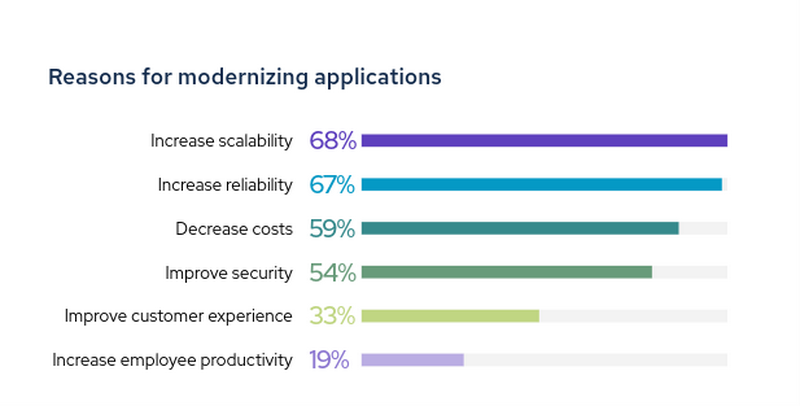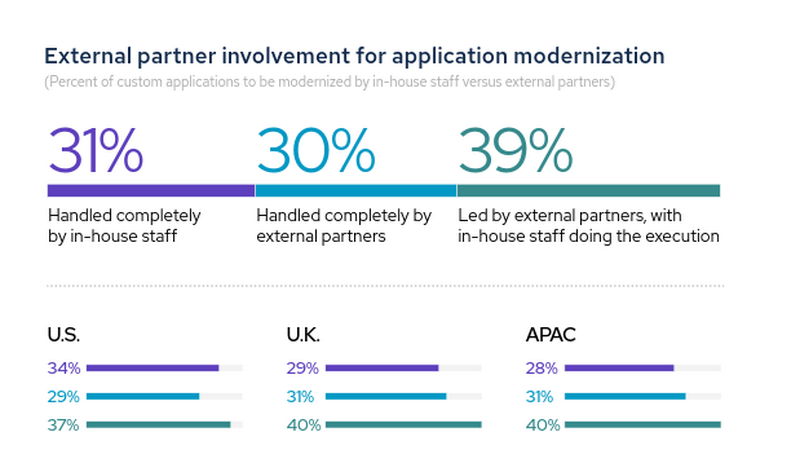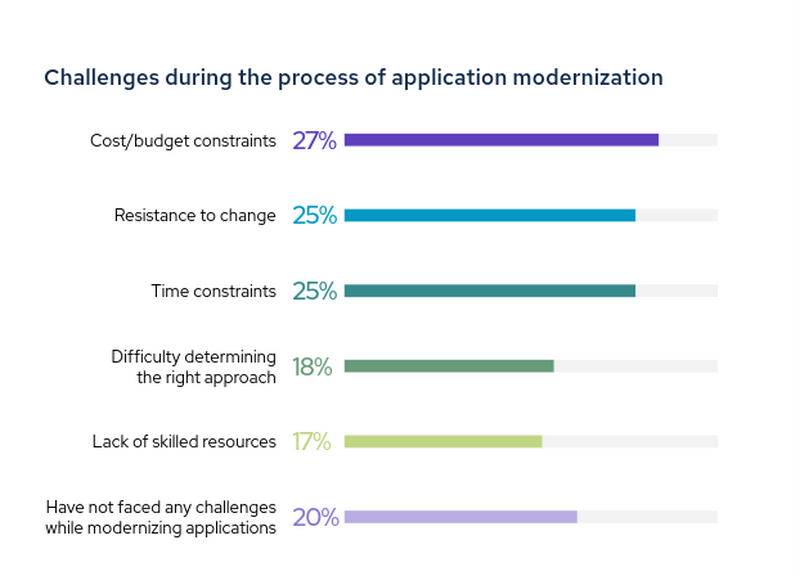Legacy Application Modernization: Why, When, and How to Do It
Legacy application modernization is a complex and costly initiative. But it is often the only way to future-proof your business and make sure your software helps you grow rather than holds you back. That’s why more and more enterprises have legacy system modernization on their agendas in the upcoming years.
Companies plan to upgrade nearly 80% of their custom applications within the next 2 years, according to a recent Red Hat survey. Source: Red Hat (2023).
If you consider modernizing your software portfolio and want to do it in the most cost-efficient, safe, and painless way, use this guide as a starting point. We will walk you through the key reasons, strategies, and benefits of app modernization. And then provide an actionable step-by-step plan to modernize legacy applications.
Legacy application modernization is the process of upgrading outdated systems to align with current and future business needs. Both ‘legacy’ and ‘modernization’ can mean different things depending on context. For example, it can refer to moving from aging technologies to new ones, migrating from on-premises hosting to the cloud, or completely reengineering software no longer relevant for business.
The most common reasons why organizations invest in modernizing legacy software are:
To enhance scalability and reliability
According to the Red Hat survey among 600 IT leaders in the US, UK, and APAC, improved scalability and reliability are the major goals of the current modernization initiatives.

Image credit: Red Hat.
Legacy applications built with dated technologies and engineering principles may become hard and costly to scale, prone to crashes, and vulnerable to security threats. Modern modernization strategies, such as migrating to a modular architecture, cloud adoption, and containerization, help to make applications more resilient and scalable.
To adjust to current and future business needs
This is, perhaps, the underlying reason why every organizatoin starts modernizing legacy applications. Regardless of priorities, goals, or strategies they use. Businesses transform their operations and services to address changing market needs. And so should their software.
The application that has been supporting business for the last decade may no longer do the job. Instead of helping the business grow, it may become a major operational challenge. So modernizing obsolete software becomes the only way for the business to adapt, compete, and grow.
To improve productivity and performance
Custom applications built years or even decades ago inevitably accumulate some technical debt and workarounds that make them harder and more expensive to handle. This affects team productivity, speed of deliveries and updates, and the overall performance of the application. In the case of customer-facing applications, it may even affect user experience and the ability to compete with newer and fresher apps.
To decrease costs
Although not the top priority, the decreased cost is another important reason for the modernization of legacy applications. Companies want to get better control over infrastructure costs, leverage flexible pricing models offered by cloud providers, and cut down on maintenance and support expenses. The latter typically grows as applications get older and more cumbersome.

How do you know when to update, upgrade, or migrate your software? Here are a few common signs that indicate it might be time to modernize legacy application:
You have to deal with increasing complexity
- The structure and code of your application get too complex.
- You notice decreasing productivity and slower development and deployment cycles.
- It’s getting too expensive to maintain and manage the application.
- Growing dependencies and compatibility issues with other applications require workarounds and tradeoffs.
It’s getting harder to troubleshoot and fix bugs
- Accumulated technical debt gets out of control.
- It gets harder to trace down and fix issues.
- You no longer have or can’t find people who can understand the app’s code and solve arising problems.
- You have to work with old unsupported technologies.
Your application is too hard and costly to scale
- Your application can no longer meet growing scalability requirements.
- Scalability and infrastructure costs increase exponentially but could be significantly reduced with legacy app modernization.
- Architecture and technologies lack the elasticity and flexibility to scale effectively.
- You don’t have visibility into your infrastructure and resource costs.
You register poor performance and user experience
- Visibly reduced speed and performance of your application.
- Analytics tools show issues with user experience, increased bounce rate, etc.
- Your application no longer competes with similar solutions in the market.
- Poor performance affects business metrics (drop in retention rate, number of orders, etc.)
Your application no longer complies with reliability and security standards
- Your system does not meet new or updated data protection and security standards.
- The application is built with platforms and frameworks that are no longer supported and pose security risks.
- You plan to expand your application to other markets/domains and have to comply with new regulations.
Your business goals change
- Your application no longer supports your workflows, operations, and business requirements.
- Legacy software slows down or limits your innovation initiatives.
- Relying on outdated software doesn’t let you effectively scale your business and adapt to market needs.
These are the common but by far not all the scenarios and challenges that organizations solve with modernization. Next, let’s walk through the key strategies on how to modernize legacy applications and the steps to implement them.

Step 1. Assess
Start with analyzing and assessing your systems and applications to define the areas that will benefit the most from modernization. Include every aspect into your assessment — your business goals, priorities, current technologies, infrastructure, integrations, available resources, costs, risks, challenges, limitations, dependencies, etc. The more thorough your assessment is, the more informed decisions you will make.
Step 2. Plan
Now that you know the areas and applications that require upgrades, you can start building a strategy for your legacy app modernization. Choose one or combine several approaches that fit your goals best. Here are some of the most common options:
Rehost
Move the application from one environment to another with no or small changes. It is fast and requires minimum resources.
Replatform
Transition from one infrastructure to the other one, usually, to the cloud to improve scalability. Legacy application replatforming requires some code adjustment to run the application on a new infrastructure. But does not involve rewriting the application.
Refactor
This strategy is focused on improving existing code, usually, to increase its readability and maintainability and enhance application performance.
Rearchitect
Rearchitecting refers to system restructuring and redesign to meet current scalability, reliability, security, and other requirements. This approach involves fundamental changes in system components and is usually implemented phase by phase.
Rebuild (or reengineer)
Reengineering involves significant changes to the functionality of the software and may include restructuring, redesign, and complete rewriting of the application to meet current business needs.
Replace
Replacing a legacy application with an off-the-shelf solution or a SaaS alternative is a viable option if no other modernization approach fits your goals or justifies the investment.
Once you have chosen the strategy, you can create a roadmap, define success metrics, estimate and secure resources, and set up the team for your modernization project.
In many cases, companies that lack tech expertise in-house or don’t want to draw development resources away from their core projects hire tech partners to help lead and implement modernization. In fact, external partners will take part in around 70% of modernization projects in the following years, according to the Red Hat survey.

Image credit: Red Hat.
Step 3. Implement
Your implementation approach will depend on the scale and strategy of your project. In many cases, it makes sense to break down the scope into smaller milestones and gradually upgrade the system. Agile methodology gives you better control over costs and changes and minimizes the risks of disrupting your business process.
Setting up modern deployment practices (CI/CD) and DevOps will help you optimize the speed and quality of releases. We also recommend starting testing early on in the development cycle to quickly detect arising issues and minimize the costs of debugging.
Modernize to future-proof your business
Leverage our tech expertise and scalable development resources to plan and implement your legacy software modernization.
GET A CONSULTATIONStep 4. Iterate
Modernizing legacy apps iteratively allows you to deliver value fast with minimum investment and then build up on it. When you are done with the first iteration, you can reevaluate your strategy and adjust your priorities based on early results and feedback.
Step 5. Monitor and measure
Measure the results of modernization based on the metrics you defined at the start (e.g., errors, performance, scalability, infrastructure costs). Depending on your goals, you may want to set up monitoring tools and practices to track these or other metrics over time. For instance, when migrating legacy applications to the cloud, you can configure in-built monitoring to track response time and latency, resource usage, load trends, etc.
Step 6. Educate
This is more of a process than a step. Integrate modernized applications and workflows into your operations and help your teams adopt them. It may require training and upskilling. But it’s essential to avoid or minimize resistance to change that inevitably appears during legacy applications modernization.
Cloud
Moving applications to the cloud helps organizations improve scalability, reduce hardware and infrastructure costs, and offload maintenance. Cloud providers offer myriad opportunities and tools to leverage the flexibility and efficiency of this technology. This makes it one of the top options for modernizing legacy applications.
Containers
Containerization and orchestration with technologies like Docker and Kubernetes have already become an industry standard to modernize legacy apps. It helps improve development and deployment cycles, enhance CI/CD, and adopt proactive DevOps practices. This results in better productivity, faster releases, and reduced maintenance costs.
Microservices
Migration to microservices is one of the most common legacy application modernization strategies to reduce scalability costs and create resilient, manageable software. By breaking down monolithic systems into smaller loosely connected modules, companies improve the reliability, agility, and maintainability of their software. And these are only some of the key advantages of microservices architecture.
SaaS
Moving to the SaaS model is another popular transformation approach. It works for organizations that want to modernize legacy web applications they run by moving them to the cloud and adopting a flexible subscription model. And for those who plan to integrate SaaS applications into their workflows to replace custom applications or services.

Image credit: Red Hat.
Despite the increasing priority and huge choice of options, many modernization projects fail. Some never deliver return on investment, others don’t meet the set goals. In fact, 79% of IT professionals admit that they once went through app modernization failure.
Some of the common challenges of legacy application modernization are:
Resistance to change
Resistance to change is one of the biggest roadblocks that prevent organizations from changing their workflows and upgrading software portfolios. This often stems from the lack of relevant skills and fear of potential disruptions and risks.
Budget constraints
The cost of modernization is another common barrier. Especially if it concerns long-term migration or reengineering projects that require significant upfront investment. However, often supporting aging applications that hold your business back turns out even more expensive than investing in modernization.
Lack of tech expertise
More often than not, organizations don’t have in-house skills and expertise to modernize legacy applications. And those who do have tech teams simply can’t divert their resources from core development projects and allocate them to refactoring or reengineering a legacy app. That’s why more and more companies consider partnering with experienced technology companies to either augment their tech teams or lead and implement modernization from A to Z.
Leverage our proven experience in software architecture, engineering, cloud, and DevOps to transform your aging applications into scalable high-performing systems that automate your processes, support your operations, and help your business grow. We will select the right strategies, plan and implement your modernization project iteratively with a focus on your goals, budget, and timeline. Among our recent successful modernization projects are:
- Complete redesign and reengineering of a 20-year-old legacy web application for a leading web-to-print brand in Canada. Learn about this success story here…
- Refactoring and reengineering of a web application for machine production monitoring that helped the client, a Swiss manufacturing company, boost performance and improve user experience. Learn about this success story here…
- Staff augmentation for a rapidly growing travel tech SaaS that enabled the client to quickly scale up the team and speed up migration to microservices. Learn about this success story here…
“Working with Digiteum has helped us immensely in scaling our development resources while ensuring high-quality deliveries. Their engineers seamlessly integrated with our teams and contributed in various areas such as support for third-party integrations, development of new features, and migration to microservices.” Oleksandr Marchenko, VP of Engineering, Lodgify.
Reach your modernization goals and ROI
Enhance the scalability, reliability, and performance of your software with high-value modernization.
GET A CONSULTATIONQuick wrap-up
We’ve talked about why and how to modernize legacy applications, walked through the major strategies and methods, and named the key technologies that can help you upgrade and future-proof your software. If you are looking for a technology partner to help you plan and implement a cost-effective and secure modernization of your legacy application, contact our tech experts.







